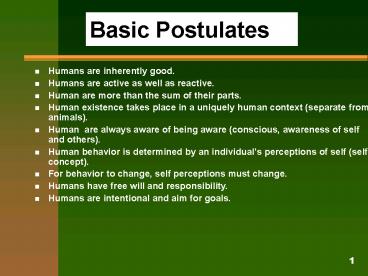MASLOW'S HIERARCHY OF NEEDS - PowerPoint PPT Presentation
1 / 15
Title:
MASLOW'S HIERARCHY OF NEEDS
Description:
What is Humanism? Dignity. Rational. Truth Seeking. Goodness. More than sum of parts ... HUMANISM. Develop the innate potential of every person. ... – PowerPoint PPT presentation
Number of Views:1896
Avg rating:3.0/5.0
Title: MASLOW'S HIERARCHY OF NEEDS
1
Basic Postulates
- Humans are inherently good.
- Humans are active as well as reactive.
- Human are more than the sum of their parts.
- Human existence takes place in a uniquely human
context (separate from animals). - Human are always aware of being aware
(conscious, awareness of self and others). - Human behavior is determined by an individuals
perceptions of self (self-concept). - For behavior to change, self perceptions must
change. - Humans have free will and responsibility.
- Humans are intentional and aim for goals.
2
What is Humanism?
- Dignity
- Rational
- Truth Seeking
- Goodness
- More than sum of parts
- Self-Actualization
- Hopeful
- Motivating
- Affirmative
- Celebratory
- Holistic
- Human Potential
- Growth
- Openness
- Enlightenment
3
HUMANISM
Develop the innate potential of every person. Let
each become all s/he is capable of becoming.
Help each individual to self-actualize.
4
Within every person is an active will towards
health, growth, and the actualization of human
potential.
Carol Tribe
5
ABRAHAM MASLOW
6
Maslows Philosophy
- To understand humans, you must understand their
highest aspirations. - Human study must be humanistic holistic
- Human values are intrinsically good desirable.
- Personality problems are loud protests against
the crushing of psychological bones. - Self-actualizing people can live more freely in
the realm of being. - A democratic environment is essential to reach
potential
7
MASLOWS HIERARCHY OF NEEDS
B E I N G
Aesthetic intellectual
- Self Actualizing Needs
- Esteem Needs
- Love and Belonging Needs
- Safety Needs
- consistency and predictability
- physical safety
- Physiological Needs
D E P R I V A T I O N
8
NEEDS DEPRIVATION
The LESS a need is deprived when it first
emerges, the BETTER a person is able to tolerate
a subsequent deprivation of that need.
THEREFORE
- If you want people to be able to tolerate food
deprivation, be certain that they never are hungry
- If you want people to be able to tolerate
- danger, be certain they always feel safe.
9
Following this logic, we can conclude
- If you want people to be able to tolerate
frustration, dont frustrate them. - If you want people to be able to tolerate
failure, be certain they succeed often. - If you want people to be able to tolerate
humiliation, be certain you are constantly
supportive of and caring toward them.
10
EMOTIONAL HEALTH
- Maslow's theory deals with emotions, not
cognition. But he does strongly maintain that
proper emotional development is crucial to
curiosity and to creative thinking. - Emotional well being is the key to thinking and
to proper learning. - One knows nothing from behavior. We have to
understand the underlying need that motivated the
behavior. A given stage can give rise to many
different behaviors. Likewise, a given behavior
can be indicative of many different stages.
11
What Should Educators Be Trying to Achieve?
- Emotional health is the goal of humanistic
education. Education should be nurturing. The
role of the teacher is to be a facilitatorto
help the child pursue her/his own interests. Each
child is unique, and educational goals for each
child must be unique.
12
The Goals of Humanistic Education
- Giving students Choice, not Controlling them
- Providing an Open not a Closed classroom
- Students are viewed as being Active, not Passive
- Self evaluation not teacher provided grades
- Facilitating vs. Teaching Facts
- . Principles vs. Facts
- Discovery vs. Acquisition
- Cooperation vs. Competition
- Creativity vs. Conventionality
- Personal Integrity vs. Beating the System
13
HIERARCHY and SEQUENCE
What Is a Hierarchy? You must successfully
complete (resolve, equilibrate) one stage before
you go to the next. How Is Hierarchy Related To
Sequence? All hierarchical theories are
sequential, but not all sequential theories are
hierarchical.
14
POTENCY of NEEDS
The needs are INNATE, but they are not of equal
potency (strength). They are arranged in a
hierarchy of potency.
AN INDIVIDUAL IS MOTIVATED BY HER/HIS MOST
POTENT UNSATISFIED NEED
15
THE NEEDS ARE UNIVERSAL
BUT
CULTURE OFTEN DETERMINES HOW THE NEEDS ARE
SATISFIED































